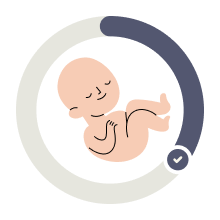As you enter week 31 of pregnancy, your baby’s brain is rapidly developing, becoming more intricate and advanced. Your baby is now more active than ever before, pedaling his feet, sucking his thumb, and honing other essential skills for life outside the womb.
In terms of your own physical experience, you may notice an increase in the frequency of your bathroom trips and feel fatigued more quickly than usual.
Pregnancy Week 31 Quick Facts
- At 31 weeks, you’re seven months and three week pregnant
- You have 9 weeks until your due time “Calculate Your Due Date”
- This is your third trimester
Your Unborn Baby’s Size at 31 Weeks
How Big is Baby?
At this point, your baby is roughly the length of a bunch of leeks, measuring around 41.1 centimeters. Your baby’s weight is about 1,500 grams or 3.31 pounds, and baby is likely to gain up to 227 grams or half a pound per week until delivery.
Pregnancy Symptoms Week 31
As you reach the 31st week of pregnancy, you can expect to experience familiar symptoms, which may vary in intensity. The most common symptoms at this stage are as follows:
- Shortness of breath
As your body becomes heavier, you may find it harder to breathe. It’s essential to avoid overexerting yourself, although it’s good to stay active. Take regular breaks and rest as needed.
- Dry, brittle nails
While you may notice increased fingernail and toenail growth, this can make them feel brittle and dry. You may find using a moisturizing cuticle oil helpful.
- Braxton Hicks contractions
Drinking plenty of water and changing positions regularly can help alleviate discomfort from Braxton Hicks contractions.
- Leaky breasts
As your body prepares for your baby’s arrival, you may experience yellowish colostrum leakage, which is normal.
- Frequent urination
Your bladder may feel just as crowded as your lungs. Although there’s not much you can do to prevent this, you can plan for more bathroom breaks.
- Backaches
Stretching can help ease your back pain, and prenatal yoga poses may be especially beneficial.
- Trouble sleeping
It’s understandable that you may have trouble sleeping due to contracting belly muscles, discomfort finding a comfortable position, and frequent bathroom breaks.
Prenatal Tests and Doctor’s Appointments
31 week ultrasound
At 31 weeks pregnant, if you have pregnancy complications like gestational diabetes or are carrying twins, you may have an ultrasound to check on your baby (or babies). However, if you don’t fall into these categories, you can skip the ultrasound this week.
But if you’re curious and want to see what your baby looks like inside your 31-week pregnant belly, you can choose to have a 3D/4D ultrasound between weeks 24 to 32. At 31 weeks, you can get a clear view of your baby’s face in a single 3D picture, and even see your baby move in 3D on the screen – blinking, sucking their thumb, and maybe even smiling or frowning. You have the option to take a video of the experience home with you!
While there are medical reasons for a 3D/4D ultrasound at 31 weeks pregnant, it’s typically an elective procedure that’s not covered by insurance, so you’ll have to pay out of pocket. If your doctor approves it and you’re interested, it can be a pretty cool experience!
Special Considerations
The amniotic fluid serves as a protective cushion for your developing baby in the uterus. As your pregnancy progresses, the volume of amniotic fluid gradually increases. By the time you reach week 34, the level usually reaches its maximum at an average of 1 and a half pints (800 milliliters). Abnormal levels of amniotic fluid, either too little or too much, can indicate a potential issue or may lead to complications in the future.
Oligohydramnios
Oligohydramnios is a condition that affects a small percentage of pregnancies, where there is too little amniotic fluid surrounding the baby. This condition can occur due to a variety of reasons, such as a problem with the placenta, leaking fluid, an issue with the baby, or for no known reason at all. Symptoms may not be present, but if the size of the baby or bump is smaller than expected, it may be a cause for concern. To diagnose oligohydramnios, an ultrasound will be used to measure the amount of amniotic fluid, and additional tests such as non-stress and contraction stress tests may be required.
Polyhydramnios
Polyhydramnios, on the other hand, is the opposite condition where there is too much amniotic fluid. This condition occurs in about 1% of pregnancies and may be caused by gestational diabetes, carrying more than one baby, a baby with a birth defect, or for no known reason. Symptoms may include difficulty breathing, abdominal discomfort, and pressure on the pelvic area. A routine ultrasound can detect polyhydramnios, and it generally does not harm the mother or the baby. If there is a concern, the provider will monitor the pregnancy more frequently.
Developmental Milestones
At this stage, your baby’s appearance closely resembles what they will look like at birth. The lanugo, which is the fine hair covering the body and protecting the skin from the amniotic fluid, is starting to disappear. The main focus for your baby now is to continue filling out and putting on some more weight, which includes that cute and cuddly baby fat!
Eyes
At around 31 weeks, an ultrasound can detect your baby’s eyelids’ tiny movements as they blink. According to research, babies blink slowly, only about 6 to 15 times per hour, in comparison to adults, who blink 19 to 20 times per minute.
Lungs
Your baby’s lungs continue to develop, and they’re still honing their breathing skills. Breathing movements increase from 10% to 20% at 28 weeks to 30% to 40% after 30 weeks.
Is the baby fully developed by 31 weeks?
Your diligent efforts of maintaining a healthy lifestyle, including proper nutrition, regular exercise, and overall well-being, are yielding positive results. You are currently 31 weeks pregnant, and your baby has undergone significant growth (with more growth yet to come!). You’re almost ready to welcome your little one, and they’re almost ready to meet you too!
Survival Outside the Womb
At 31 weeks, your baby is in the final week of the very preterm category. As each week progresses, the chances of survival without prematurity-related disabilities improve. Although babies may still require specialized care in the NICU for several weeks, the survival rate at 31 weeks is up to 99%.




